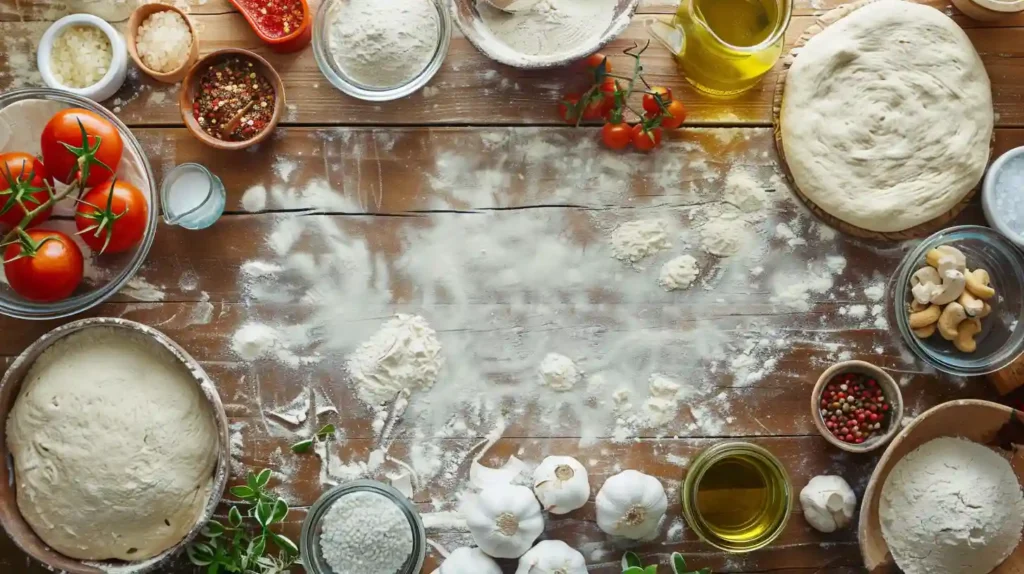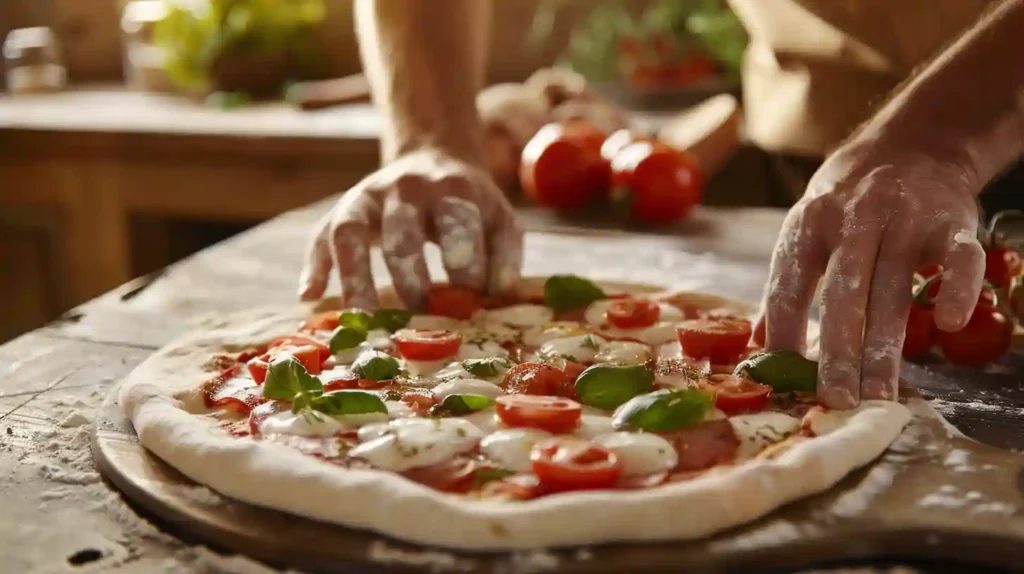Secret to Irresistible Pizza Dough Revealed!
The key to making an exceptional pizza lies in its foundation. While toppings can certainly elevate a pie, it’s the pizza dough that truly sets the stage for a memorable culinary experience. Whether you prefer a thin, crispy crust or a thick, chewy base, the quality of your dough can make or break your pizza night.
In this blog post, we will delve into the secrets behind creating irresistible pizza dough that not only complements your favorite toppings but also stands out on its own. From understanding the essential ingredients to mastering the techniques that yield that perfect rise and texture, we’ll guide you through every step of the process. So roll up your sleeves and get ready to discover how to transform simple ingredients into a deliciously satisfying pizza dough that will have everyone coming back for seconds!
The Perfect Ratio of Flour to Water
Achieving the ideal pizza dough requires finding the perfect balance between flour and water. In my early attempts, I often found myself either with a dough that was too dry or one that was overly sticky and unmanageable. After much trial and error, I discovered that a hydration level of around 60-65% works wonders for a well-balanced dough.
This means for every 100 grams of flour, you should use about 60-65 grams of water. It’s a simple ratio, but it took me a while to get it just right. I remember one particular evening when I was hosting friends for a pizza night.
I meticulously measured out my ingredients, ensuring that my flour-to-water ratio was spot on. While I was mixing the dough, I could sense it forming perfectly, smooth and elastic. When it finally rose, it was like watching a magic trick unfold.
The dough was pliable and easy to shape, allowing me to create perfectly round pizzas that my friends devoured in minutes. That night reinforced my belief in the importance of precision when it comes to ratios.

The Role of Yeast in Pizza Dough
Yeast is often referred to as the magic ingredient in bread-making, and I couldn’t agree more. The first time I used yeast in my pizza dough, I was amazed at how it transformed a simple mixture of flour and water into something alive and bubbly. Yeast ferments the sugars in the dough, producing carbon dioxide gas that causes it to rise.
This process not only gives the dough its airy texture but also contributes to its flavor profile. I vividly recall a baking session where I decided to experiment with different types of yeast. I had some instant yeast on hand and some active dry yeast, so I split my dough into two batches.
The instant yeast produced a quicker rise, while the active dry yeast took its time but developed a richer flavor. When it came time to bake, I could taste the difference in each crust. It was a delightful reminder of how yeast plays a pivotal role in creating that perfect pizza base.

Perfecting the Art of Kneading and Letting the Dough Rest
| Technique | Benefits |
|---|---|
| Kneading | Develops gluten, improves texture, and helps dough rise |
| Resting | Giving the dough time to rest loosens the gluten, simplifies shaping, and enhances its flavor. |
Kneading is an essential step in developing gluten in your pizza dough, and over time, I’ve come to appreciate it as an art form. Initially, I approached kneading with a sense of dread; it felt like a workout! However, as I practiced, I learned to enjoy the rhythmic motion of folding and pressing the dough.
Kneading not only strengthens the gluten but also helps incorporate air into the mixture, which is vital for achieving that light texture. Resting the dough is equally important. After kneading, I typically let my dough rest for at least an hour or until it doubles in size.
This stage helps the gluten to loosen, which simplifies shaping afterward. One memorable experience was when I decided to let my dough rest overnight in the fridge. The next day, when I pulled it out, it had developed a beautiful flavor and texture that made my pizzas taste gourmet.
It’s incredible how patience can result in such tasty outcomes.
Tips for Achieving the Ideal Texture and Consistency
Achieving the ideal texture and consistency in pizza dough can be tricky, but I’ve picked up some tips along the way that have made all the difference. One key aspect is to pay attention to your environment; humidity and temperature can affect how your dough behaves. On particularly humid days, I’ve noticed that my dough tends to be stickier than usual, so I adjust by adding a little extra flour during kneading.
Another tip I’ve found helpful is to use a bench scraper when working with sticky dough. This handy tool allows me to lift and fold without making a mess or getting my hands too sticky. Additionally, I’ve learned that letting my dough rest longer can enhance its flavor and texture significantly.
Sometimes, I’ll prepare my dough in the morning and let it rise slowly throughout the day, this slow fermentation process creates a depth of flavor that is simply unmatched.
The Secret to Flavorful Pizza Dough
The Power of Salt
Salt is another crucial ingredient that plays a dual role in enhancing flavor while controlling yeast activity during fermentation. This balance is essential in creating a well-rounded flavor profile.
Experimenting with Herbs
I recall an evening when I decided to experiment by adding herbs directly into my dough – dried oregano and basil were my go-to choices. The aroma that filled my kitchen as it baked was heavenly! Each bite of pizza had an extra layer of flavor that made it feel special.
Transforming Your Pizza
It’s these little tweaks that can transform your pizza from something simple into a culinary masterpiece. By incorporating these ingredients and experimenting with different flavors, you can take your pizza to the next level and create a truly unforgettable dining experience.
The Key to Achieving a Crispy Crust
A crispy crust is often what separates good pizza from great pizza, and I’ve spent countless hours perfecting this aspect of my pizza-making process. One of the most effective methods I’ve found is preheating my pizza stone or baking steel in the oven before placing the pizza on it. This ensures that the bottom cooks quickly, resulting in that coveted crunch.
Another trick I’ve learned is to stretch my dough rather than rolling it out with a pin. This technique preserves air bubbles within the crust, which contributes to its lightness and crispiness when baked. One memorable pizza night involved me stretching out a particularly well-risen batch of dough; as it hit the hot stone, it puffed up beautifully, creating an irresistible crust that had everyone coming back for seconds.
How to Store and Use Pizza Dough for Best Results
Storing pizza dough properly can extend its shelf life and enhance its flavor over time. I’ve found that wrapping my prepared dough tightly in plastic wrap and placing it in an airtight container works wonders for keeping it fresh in the fridge for up to three days. If I’m not planning on using it right away, I’ll often freeze portions of dough for later use.
When I’m ready to use frozen dough, I take it out a day ahead and let it thaw slowly in the fridge overnight. This slow thawing process allows for continued fermentation, which enhances flavor even further. One time, I pulled out some frozen dough for an impromptu pizza night with friends; they were amazed at how fresh and flavorful it tasted despite being frozen!
Proper storage techniques have truly transformed how I approach making pizza at home, ensuring that every bite is as delicious as possible.

Conclusion
In summary, it can be concluded that…, the journey to mastering the art of pizza dough is both an exciting and rewarding endeavor. By understanding the fundamental components that contribute to an irresistible pizza crust, you can elevate your homemade pizzas to a whole new level. From selecting high-quality ingredients to perfecting your kneading technique and allowing for adequate fermentation, each step plays a crucial role in achieving that perfect balance of flavor and texture.
As we’ve explored throughout this blog post, the secret to exceptional pizza dough lies not just in the recipe itself but also in the process and care you put into it. Experimenting with different types of flour, hydration levels, and fermentation times can lead to delightful variations that cater to your personal taste preferences. Remember, practice makes perfect; don’t be discouraged by initial attempts that may not turn out as expected.
Moreover, the beauty of pizza dough is its versatility. Whether you prefer a thin and crispy crust or a thick and chewy base, there’s a method out there for everyone. Embrace the creativity that comes with making your own dough, try adding herbs or spices for an extra kick or experimenting with different toppings that complement your unique crust.
Ultimately, the secret to irresistible pizza dough is about finding joy in the process and sharing delicious creations with friends and family. So roll up your sleeves, gather your ingredients, and start crafting your own signature pizza dough today. With time and experimentation, you’ll soon discover that making pizza at home can be just as satisfying as ordering from your favorite pizzeria, if not more so! Happy baking!
FAQs
What is the secret to irresistible pizza dough?
The secret to irresistible pizza dough lies in using high-quality ingredients, achieving the perfect ratio of flour to water, understanding the role of yeast, mastering the art of kneading and resting the dough, and incorporating tips for achieving the ideal texture and consistency.
What makes quality ingredients crucial for pizza dough?
The quality of ingredients is essential in pizza dough because they significantly affect the taste, texture, and overall excellence of the finished product. Opting for top-notch flour, water, salt, and yeast will lead to a better pizza dough.
What is the ideal proportion of flour to water for making pizza dough?
The ideal proportion of flour to water in pizza dough is generally about 3:2, meaning 3 parts flour to 2 parts water. This ratio can vary a bit based on the type of flour and the particular recipe.
How does yeast function in pizza dough?
Yeast plays a crucial role in making the pizza dough rise, giving it a light and airy texture. It also enhances the flavor and aroma of the dough by fermenting and releasing carbon dioxide gas.
What are the skills involved in kneading and allowing dough to rest?
Kneading the dough requires manipulating and stretching it to form gluten, which provides the dough with its structure and flexibility. Allowing the dough to rest lets the gluten relax and the yeast ferment, leading to a dough that is easier to handle and more flavorful.
How can you achieve the perfect texture and consistency in pizza dough?
Some tips for achieving the ideal texture and consistency in pizza dough include using the right type of flour, measuring ingredients accurately, kneading the dough thoroughly, and allowing it to rest and rise properly.
What is the secret to flavorful pizza dough?
The secret to flavorful pizza dough lies in using high-quality ingredients, allowing the dough to ferment and develop complex flavors, and incorporating herbs, spices, or other flavorings to enhance the taste.
How can you achieve a crispy crust in pizza dough?
To get a crispy crust on your pizza dough, bake it at a high temperature with a pizza stone or steel to transfer heat directly to the dough, and ensure the crust is relatively thin.
For the best outcomes, how should one store and utilize pizza dough?
Pizza dough can be stored in an airtight container in the refrigerator for up to three days or frozen for as long as three months. Allow the dough to come to room temperature before shaping and baking according to your recipe.

Secret to Irresistible Pizza Dough Revealed!
Ingredients
- 3 ½ cups All-purpose flour Can be substituted with whole wheat or gluten-free flour, but it may affect texture.
- 1 cup Warm water Ensure water is between 100°F and 110°F (38°C to 43°C) to properly activate the yeast.
- 2 ¼ tsp (1 packet) Active dry yeast Instant yeast can be used as a substitute, and it doesn't require activation in water.
- 2 tbsp Olive oil Extra virgin olive oil adds more flavor, but regular olive oil works too.
- 1 tsp Salt Can be adjusted for taste; kosher salt is also a good option.
- 1 tsp Sugar Optional, helps activate yeast and enhances the dough's texture.
Instructions
- Activate the Yeast:In a small bowl, mix warm water and sugar. Sprinkle the yeast on top and let sit for 5–10 minutes until foamy.
- Mix the Dough:In a large mixing bowl, combine the flour and salt. Add the yeast mixture and olive oil. Stir until a shaggy dough forms.
- Knead the Dough:Transfer to a floured surface and knead for 8–10 minutes until smooth and elastic. Add flour as needed to prevent sticking.
- Let It Rise:Place the dough in a lightly oiled bowl, cover with a damp towel or plastic wrap, and let it rise in a warm spot for 1 hour, or until doubled in size.
- Punch and Shape:Punch down the dough, then divide and shape into pizza crusts. Let rest for 10 minutes before adding toppings.
- Bake or Store:Top with sauce and toppings of choice, then bake as desired. Alternatively, store dough in the fridge (up to 3 days) or freezer (up to 3 months).
Notes
You can use whole wheat flour for a slightly denser dough or gluten-free flour for a gluten-free version. If using gluten-free flour, make sure to use a blend designed for pizza dough for best results. Yeast Activation:
If using instant yeast, you can skip the activation step (mixing it with warm water) and directly add it to the dry ingredients. Rising Time:
The dough needs to rise in a warm, draft-free area for about 1 hour. If you’re in a cooler climate, you can let the dough rise for longer or place it in an oven with the light on to maintain warmth. Freezing the Dough:
If you want to make pizza dough ahead of time, you can freeze the dough after the first rise. Just wrap it tightly in plastic wrap and place it in a zip-top bag. When ready to use, allow it to thaw in the fridge overnight before shaping. Kneading Tip:
When kneading the dough, it should be smooth and slightly tacky, but not sticky. If the dough is too sticky, add a little more flour; if too dry, add a few drops of water. Dough Texture Variations:
For a crispier crust, roll the dough thinner; for a chewier, thicker crust, leave it a little thicker. You can also experiment with adding garlic powder, herbs, or even a bit of Parmesan cheese to the dough for extra flavor. Room Temperature Ingredients:
If your ingredients, especially the olive oil and water, are too cold, it might slow down the rising process. It’s best to use room-temperature ingredients. Baking Tip:
For the best results, bake your pizza on a preheated pizza stone or a baking sheet in a very hot oven (450°F/232°C). This gives the crust a nice, crispy finish.








